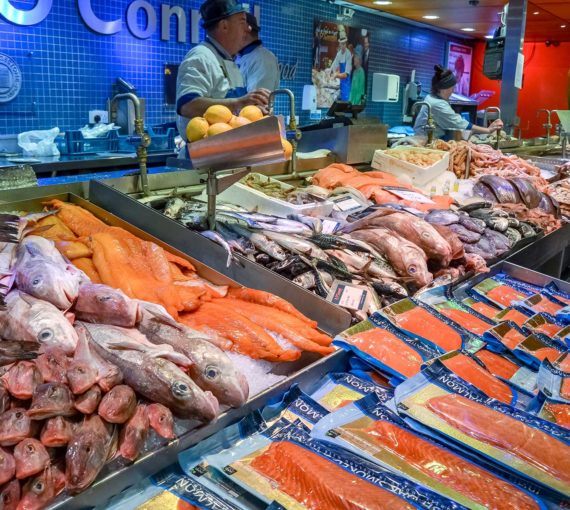
Seafood Progress makes it easier for consumers to find out retailers’ policies on sustainable seafood, whether they’re adhering to those policies and how they’re performing compared to their peers. (Photo: Colin Czerwinski via Unsplash)
Oceans hold a lot of mystery, even for people who study them. But it’s no mystery why they’re in trouble. We’ve been using them to hide our waste — dumping oil, plastic, toxic chemicals, radioactive sludge, sewage and fishing gear into them for decades. Oceans also absorb much of the atmospheric heat from our indiscriminate fossil fuel burning. And we’ve been taking everything we can from them, including fish, seaweed, plankton, minerals and oil.
We’ve exploited many fish stocks to levels so low they can no longer be harvested. Ocean acidification and warming water from climate disruption are wiping out corals, shellfish and reef fish at a shockingly rapid rate.
We depend on oceans for so much, including half the oxygen that keeps us alive! They’re also a primary source of protein for millions of people worldwide.
If we want to continue to enjoy all that oceans provide, we need to do everything we can to protect them and the life they support. Some people argue we should no longer eat seafood. We’ve reached that point for some species and are nearing it for many others, but it doesn’t have to be that way. We can ensure the seafood we eat is caught and produced in ways that don’t compromise stocks, the environment or human rights.
I still eat fish and have fished all my life. When I was young, my dad and I would catch salmon, sturgeon and halibut from the shores of English Bay and the Fraser River. Now there aren’t enough fish left. I still enjoy being on the water — catching, cleaning, preparing and eating fish — but I’m aware many species are declining. I don’t fish as often as I used to, and I make sure I catch from sustainable stocks and use the entire fish, but as populations plummet there are fewer sustainable options.
As public and corporate awareness about the risks posed by overfishing and uncontrolled aquaculture expansion have grown, food retailers in Canada have developed sustainable seafood policies and commitments.
Of course, not everyone is lucky enough to be able to catch their own fish, which means having sustainable options at the store is critical. As public and corporate awareness about the risks posed by overfishing and uncontrolled aquaculture expansion have grown, food retailers in Canada have developed sustainable seafood policies and commitments. Many started sourcing eco-labelled products so consumers could see which products were the best choices.
Despite promising first steps, some sellers and suppliers have become complacent about seafood improvement plans. As a result, achieving sustainability throughout the seafood industry supply chain remains a work in progress.
To help provide incentives to retailers and information to seafood lovers, SeaChoice (a collaboration between the David Suzuki Foundation, Ecology Action Centre and Living Oceans Society) has developed Seafood Progress, an online resource. It makes it easier for consumers in Canada to find out retailers’ policies on sourcing sustainable seafood, whether they’re adhering to those policies and how they’re performing compared to their peers.
In its recent second assessment, Seafood Progress found retailer performance improved. Some was due to increased transparency, including two new companies that signed on to provide previously unpublished information. Positive new initiatives also helped, including more regular disclosure of performance against commitments, publishing information about where products come from and how they’re produced, and new actions to support improvements for seafood commodities that continue to have sustainability concerns.
Retailers must do more to ensure their seafood products are environmentally sustainable and socially responsible.
But retailers must do more to ensure their seafood products are environmentally sustainable and socially responsible. This means expanding the scope of their commitments to cover all seafood products they sell, in all their stores. It also requires continuing to work with suppliers and producers to improve practices across the board and make sure the sustainable seafood supply meets consumer demand.
Unsustainable seafood is common in the Canadian marketplace. But it doesn’t have to be. Canada’s major retailers have a responsibility to meet their customers’ expectations that seafood production doesn’t take more fish than can be replenished, harm or kill marine animals unnecessarily, pollute watersheds and wetlands or exploit vulnerable people.
Meaningful commitments to sustainable procurement by Canada’s largest seafood businesses will go a long way toward achieving this. It’s no mystery that if we want to continue to eat fish, we must do it responsibly. Seafood Progress has invited seafood retailers, suppliers and consumers to join in pushing to achieve this goal.



